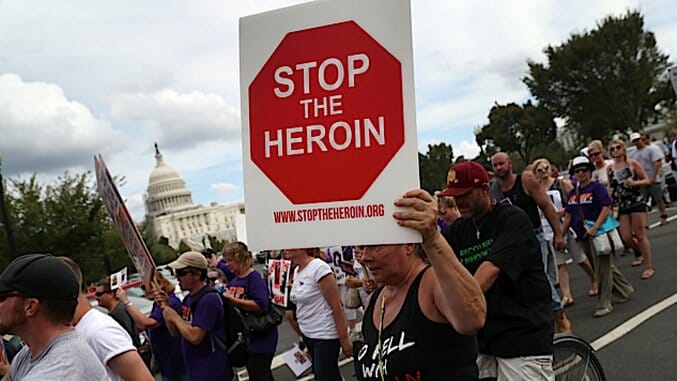We Are in the Midst of America’s Worst Drug Epidemic
Photo by John Moore/Getty
America is in the midst of the worst drug epidemic in its history, and you might not know it.
An opioid epidemic has been developing for years, and heroin and opioid overdoses now kill around 27,000 people a year, more people per year than died during the height of the AIDS crisis, die each year from gun deaths, and even die each year from car crashes, just to name a few. According to the Center for Disease Control (CDC), more people died from drug overdoses in 2014 than in any year on record in the US previously. “The majority of drug overdose deaths (more than six out of ten) involve an opioid. And since 1999, the number of overdose deaths involving opioids (including prescription opioid pain relievers and heroin) nearly quadrupled.” The CDC also noted that 78 Americans die every day from an opioid overdose.
While you may have heard about the epidemic, particular in relation to an increase in deaths among older, rural, whites, it seems like the issue has somehow managed to fly under the radar this presidential cycle, with the fixation on issues like walls, immigration, terrorism, and Donald Trump.
This shouldn’t be the case.
With the proliferation of opioid prescriptions though, can we say this is wholly unexpected?
Opioid deaths from overdoses have increased in tandem with a steep increase in the prescribing of opioids The number of prescription opioids sold in 2010 was four times the number sold in 1999, according to the American Society of Addiction Medicine (ASAM). In 2012 alone, there were 259 million prescriptions written for opioids. That is enough to provide every American adult with a bottle of opioid pills.
Opioids also provide a gateway into heroin use. Among new heroin users, three out of four reported abusing prescription opioids before they began using heroin, the CDC found. Why? Opioids are expensive and require a prescription to get. Once struggling with addiction, people have found that heroin has better availability and a lower price. The DEA found that the amount of heroin seized each year at the southwest border of the United States was approximately 500 kg during 2000-2008. This amount quadrupled to 2,196 kg in 2013.
That being said, if taken as prescribed for pain, the drugs typically do not lead to addiction. Among those who take opioids as for a year as directed, only about about 5 percent will develop an addiction disorder, according to the National Institutes of Health.
Still, heroin-related deaths more than tripled between 2010 and 2014. The largest increase in overdose deaths from 2013 to 2014 was for those involving synthetic opioids (other than methadone), which rose from 3,105 deaths in 2013 to 5,544 deaths in 2014. One of these synthetic opioids, illegally-made fentanyl, drove the increase and deserves particular attention. Often, fentanyl is mixed with heroin and/or cocaine as a combination product—with or without the knowledge of those taking it.
A 2016 report found that death from fentanyl overdose has increased greatly in in eight U.S. states — Massachusetts, Maine, New Hampshire, Ohio, Florida, Kentucky, Maryland and North Carolina. These states had had large increases in overdose deaths tied to synthetic opioids other than methadone, which is a category that includes fentanyl, the report found.
Six of these states report specifically on their number of fentanyl-related deaths, and their combined death toll from fentanyl increased from 392 deaths in 2013 to 1,400 deaths in 2014. The drug is up to 100 times for potent than the well-known drug morphine, and it was a fentanyl overdose that caused the death of the musical artist Prince this past April.